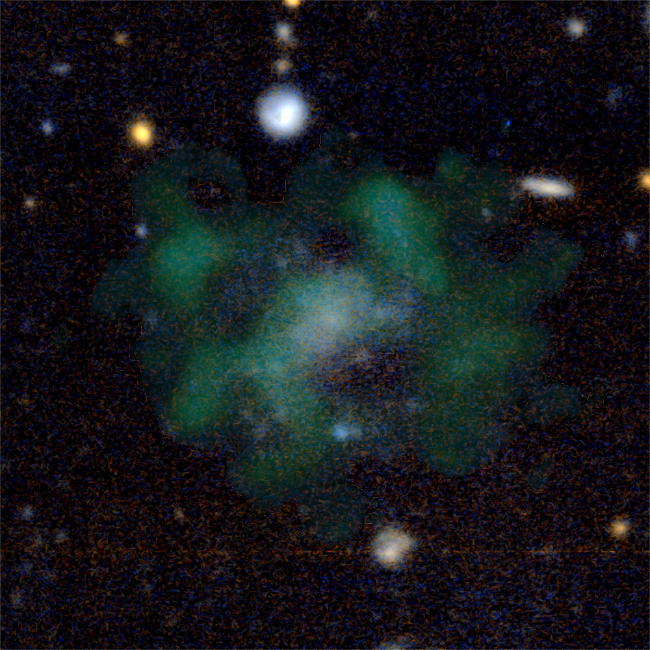Zelfs na 40 uur extra scherp meten geen spoor van donkere materie bij sterrenstelsel AGC 114905
Een internationaal team van onderzoekers onder Groningse leiding heeft ook na veertig uur meten met extra goede telescopen geen spoor van donkere materie vastgesteld bij het sterrenstelsel AGC 114905. Ze publiceren hun bevindingen binnenkort in het vakblad Monthly Notices of the Royal Astronomical Society.
Ga nog maar eens goed meten, want dan zul je zien dat er wél donkere materie rond jullie sterrenstelsel zit. Dat hoorden Pavel Mancera Piña (Rijksuniversiteit Groningen en ASTRON) en collega's nadat ze eind 2019 zes sterrenstelsels hadden ontdekt met amper tot geen donkere materie. Maar na veertig uur extra meten met behulp van de Very Large Array in het Amerikaanse New Mexico blijken de bewijzen voor een donkerematerieloos sterrenstelsel alleen maar sterker.
Het sterrenstelsel in kwestie is AGC 114905 op zo'n 250 miljoen lichtjaar van ons vandaan. Het is een zogeheten ultradiffuus dwergsterrenstelsel. De naam dwergsterrenstelsel slaat op de lichtzwakte en niet op zijn grootte. Het sterrenstelsel is namelijk ongeveer zo groot als onze eigen Melkweg, maar bevat duizend keer minder sterren. Het heersende idee is dat alle sterrenstelsels, en zeker ultradiffuse dwergstelsels, alleen kunnen bestaan als het door donkere materie bij elkaar wordt gehouden.
Draaisnelheid in grafiek
De onderzoekers verzamelden tussen juli en oktober 2020 uur met behulp van de VLA-telescoop veertig uur lang gegevens over draaiing van gas in AGC 114905. Vervolgens maakten ze een grafiek met op de x-as de afstand van het gas tot het centrum van het sterrenstelsel en op de y-as de draaisnelheid van het gas. Dat is een beproefde manier om donkere materie te onthullen. Uit de grafiek blijkt dat de draaisnelheid van het gas in AGC 114905 compleet te verklaren is met alleen maar normale materie.
"Dat is natuurlijk wat wij dachten en hoopten, want het bevestigt onze eerdere metingen." zegt Pavel Mancera Piña "Maar ja, nu blijft het probleem bestaan dat de theorie voorspelt dat er donkere materie moet zijn in A114905, maar dat onze waarnemingen zeggen van niet. Sterker nog, het verschil tussen theorie en waarneming wordt alleen maar groter."
Mogelijke verklaringen
In hun wetenschappelijke publicatie lopen onderzoekers de mogelijke verklaringen voor het ontbreken van donkere materie één voor één langs. AGC 114905 zou bijvoorbeeld van donkere materie ontdaan kunnen zijn door grote sterrenstelsels in de buurt. Mancera Piña: "Maar die zijn er niet. En in het bekendste raamwerk voor de vorming van sterrenstelsels, het zogeheten cold-dark-mattermodel, zouden we extreme parameterwaarden moeten invoeren die ver buiten het gebruikelijke bereik liggen. Ook met modified Newtonian dynamics, een alternatieve theorie, kunnen we de gasbewegingen niet reproduceren."
Volgens de onderzoekers zou er nog één aanname die roet in het eten kan gooien. Dat is de geschatte hoek waaronder ze het sterrenstelsel denken waar te nemen. "Maar die hellingshoek moet wel heel erg afwijken van onze schatting wil er weer plaats zijn voor donkere materie," aldus medeauteur Tom Oosterloo (ASTRON).
Onderzoek staat niet alleen
Ondertussen zijn de onderzoekers nog een tweede ultradiffuus dwergsterrenstel in detail aan het bekijken. Als ook bij dat sterrenstelsel geen sporen van donkere materie aanwezig lijken te zijn, maakt dat de zaak rond donkerematerie-arme sterrenstelsels nog sterker.
De onderzoeken van Mancera Piña en collega's staan niet op zichzelf. Eerder al ontdekte bijvoorbeeld de Nederlandse Amerikaan Pieter van Dokkum (Yale University, Verenigde Staten) een sterrenstelsel met nauwelijks donkere materie. De techniek en de metingen van Mancera Piña's team zijn nog preciezer.
Wetenschappelijk artikel
No need for dark matter: resolved kinematics of the ultra-diffuse galaxy AGC 114905. Door: Pavel E. Mancera Piña (1,2), Filippo Fraternali (1), Tom Oosterloo (2), Elizabeth A.K. Adams (2,1), Kyle A. Oman (3) & Lukas Leisman (4,5). Geaccepteerd voor publicatie in Monthly Notices of the Royal Astronomical Society. Gratis preprint: https://arxiv.org/abs/2112.00017
1. Kapteyn Instituut, Rijksuniversiteit Groningen
2. ASTRON, Netherlands Institute for Radio Astronomy
3. Institute for Computational Cosmology, Department of Physics, Durham University, Verenigd Koninkrijk
4. Department of Physics and Astronomy, Valparaiso University, Indiana, Verenigde Staten

Bron: NOVA/astronomie.nl
